Many beauticians experience some asymmetry of their nostrils after revision rhinoplasty in Iran. Apart from the temporary factors that will disappear after a year, it should be noted that:
Slight nasal asymmetry is normal. This asymmetry of the nostrils is perfectly normal if it is not easily recognizable and you should not be too strict. However, obvious asymmetry is something that makes you unhappy with the results of your nose surgery.
Notice if the asymmetry in the nostrils is easily visible on the front of the nose or not. That is, can others perceive it when they look at you directly? Or when you look at your nose from under your nose (called the main view),
is the asymmetry visible after revision rhinoplasty in Iran?
You should be able to get a nose with symmetrical holes as much as possible after the recovery period, but the fact is that you will never have a “perfect” nose; Even after nose job or revision rhinoplasty. It is important that the front of your nose looks symmetrical; Then, from the bottom, the holes should be the same size and shape as possible.
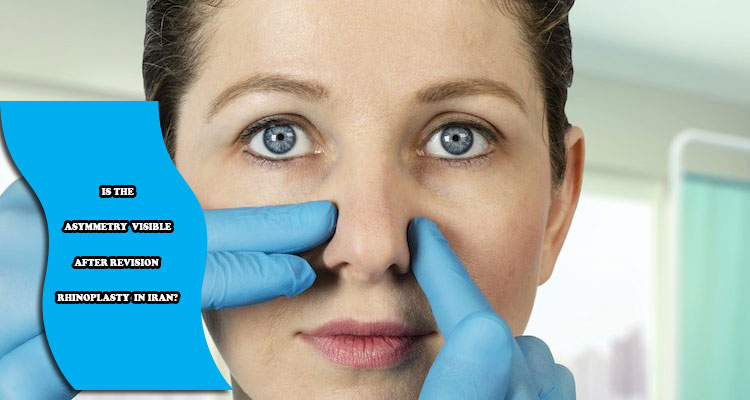
1.Swelling after revision rhinoplasty in Iran
The most important reason for postoperative nasal asymmetry is postoperative swelling. As with any surgery, there will be tenderness and swelling after your nose surgery. Because you will not experience this swelling exactly the same on each side, asymmetry is perfectly normal after nose surgery.
Swelling or deformity may occur in the nostrils, sides, and bridge of the nose after surgery. After the swelling subsides, the initial results of your rhinoplasty in Iran take about two to three months. However, it is still too early to know what elements of nasal asymmetry will remain in the long run.
On average, the final results of nose job occur between six and twelve months after surgery. Some swellings may persist during this time and may even increase and then decrease depending on the passing of time. For example, you may see more swelling after sleep and less during the day.
2.Nose anatomy and primary problem
Sometimes the nose anatomy does not allow the surgeon to make perfectly symmetrical holes for you. Unless you sacrifice the symmetry of the nose from the front view to reach the symmetrical holes from the bottom view up. Our primary goal is always to create maximum symmetry in the front view. Of course, if we achieve the symmetry of the nostrils in the main view (bottom view) is excellent, but the priority will definitely be the front view.
Related post you can read: 10 important questions about revision rhinoplasty in Iran
The highly specialized and experienced surgeon usually tries to create the symmetry of the nostrils in a way that does not sacrifice the appearance of the forehead and the front view of the nose.

3.Problems with the tip of the nose (revision rhinoplasty in Iran)
Another reason for the asymmetry of the nostrils is the problem with the tip of the nose before and after surgery and the rotation of the tip of the nose.
Sometimes this rotation is a temporary complication and resolves. Sometimes it will require “revision surgery“. Of course, the initial shape of the nose and the amount of rotation of the tip of the nose before the operation should be the criterion.
4.Muscular imbalance
Dynamic changes in the shape of the nose can also be a cause of asymmetry, which is usually not corrected by rhinoplasty alone and requires other complementary operations. For example, in some people, dynamic changes are seen when smiling and making the nostrils asymmetrical.
5.Lack of care
One of the most common causes of crooked nostrils after surgery is poor postoperative care; such as strenuous physical activity, improper sleeping or sitting, touching and pressing on the nose, smoking before and after surgery, and…
6.Nasal bone drift
Crooked nose after surgery may be due to nasal bone drift. The recovery period after rhinoplasty is a dynamic process and many changes occur in the nose after surgery. So we have to wait until the frame and skeleton of the nose reach its final form.
7.Surgical problems
revision rhinoplasty in Iran always involves two separate procedures and operations on the left and right sides of the nose. Asymmetry on both sides may be due to non-uniform correction on both sides of the nose. For example, removing too much cartilage on one side can cause asymmetric holes. In these cases, revision rhinoplasty in Iran will be needed.
8.The severity of the scars
Sometimes the severity of the scar and suture in some people is so great that it causes the tip of the nose or its holes to crook. Especially in those who have had heavy nose surgery with severe changes. So you have to wait until the scars are completely healed.
9.Skin thickness
The thicker the skin of the nose, the greater the effect of not removing the swelling and placing the skin in its original place. In these cases, it takes time for the holes to reach balance.
10.Gravity
Gravity is one of the factors that will keep the tip of the nose down until the swelling is completely eliminated. For this reason, it is very important to observe the position of the head at the right angles in the first weeks.
11.Middle cartilage disharmony
The cartilage that forms the lower nose may form asymmetrically. This asymmetry causes large and small holes in the nose. By repositioning these cartilages, a change in the size of the nostrils can be made.
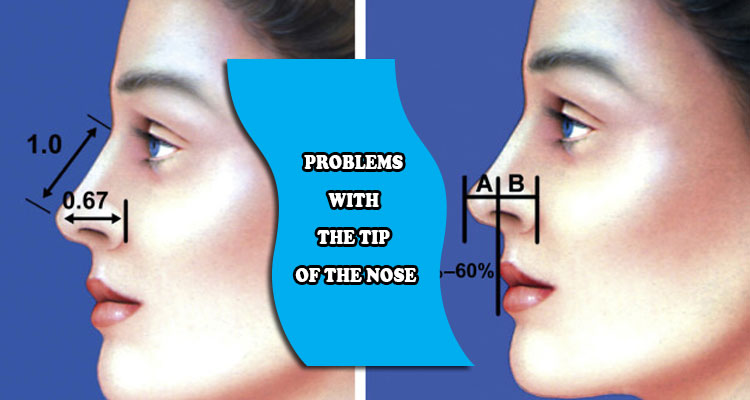
What is septal deviation (revision rhinoplasty in Iran)?
The septum is a cartilage in the nose that segregates the two nostrils. Typically, it is located in the center and divides the nostrils evenly. However, this is not the case with all the people. Many people have an uneven septum that makes one nostril larger than the other.
Severe unevenness is known as septal deviation. It can cause health problems such as blocked nostrils or difficulty breathing.
What causes septal deviation?
Septal deviation can be congenital. This has this meaning that a person was born with this characteristic. It may also occur as a result of damage to the nose. People often get these injuries as a result of contact sports, fights or car accidents. Septal deviation can also get worse with age.
What are the symptoms of a septal deviation?
Most people who have a deviated septum have only a slight deviation. Symptoms are unlikely in these cases. However, possible symptoms include:
- Difficulty breathing, especially through the nose
- Having a side of the nose that is easier to breathe through
- nose bleeding
- Sinus infections
- Dryness in a nostril
- Snoring or loud breathing during sleep
- Nasal congestion or pressure
Severe deviation can be accompanied with facial pain. If you have frequent nosebleeds or sinus infections, you should see your doctor. You should also see a doctor if breathing problems affect your quality of life.

How is nasal septal deviation diagnosed?
To diagnose a deviated septum, your doctor will first examine your nostrils with a nasal speculum. The doctor examines the location of the septum and its effect on the size of the nostrils. Your doctor will also ask questions about sleep, snoring, sinus problems, and difficulty breathing.
How is nasal septal deviation treatment?
In most cases, treatment is not necessary. For severe septal deviation, surgery is a common treatment option. Because of costs, risks, or other factors, some people with a deviated septum prefer not to have surgery. Other treatment options are available. They do not dissolve the deviation of the nasal septum, but they can reduce the accompanying symptoms.
To help with the symptoms, treatment focuses on correcting the problem. Common treatments for symptoms include:
- Decongestants
- Antihistamines
- Nasal steroid spray
- Nose strips
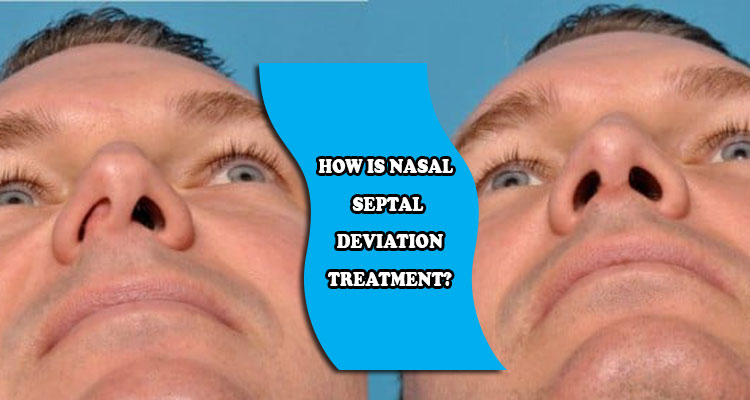
surgery
If your symptoms do not improve with medication or other treatment, your doctor may suggest a revision surgery called a septoplasty in Iran.
1.Preparation:
To prepare, you should avoid taking drugs such as aspirin or ibuprofen for two weeks before and after surgery. These medications may augment your risk of bleeding. You should also quit smoking, as it can interfere with your recovery process.
2.Method:
Septoplasty takes about 90 minutes and is performed under anesthesia. Depending on your surgeon and specific case, you may receive local or general anesthesia. During this operation, the surgeon cuts the septum and removes the extra cartilage or bone. This will straighten your septum and nasal passages. Silicone splints may be placed in each nostril to support the septum. The incision then will be sutured.
3.Complications:
You will be monitored for complications immediately after surgery and you can probably go home the same day. Septoplasty is generally a safe procedure for most people who can be anesthetized. The remaining risks are:
- Altering the shape of the nose
- Persistence of problems even after surgery
- Excessive bleeding
- Decreased sense of smell
- Short-lived numbness in the upper gums and teeth
- Septum hematoma (blood mass)
How is recovery after septoplasty?
During recovery from septoplasty, your doctor may prescribe medication. Taking it can reduce the risk of postoperative infection or help manage pain or discomfort. It is important to take all the medications your doctor prescribes.
You should also avoid disturbing your nose during recovery. The septum becomes relatively stable three to six months after surgery. Some changes may still occur up to a year later. To prevent this, avoid hitting the septum as much as possible.
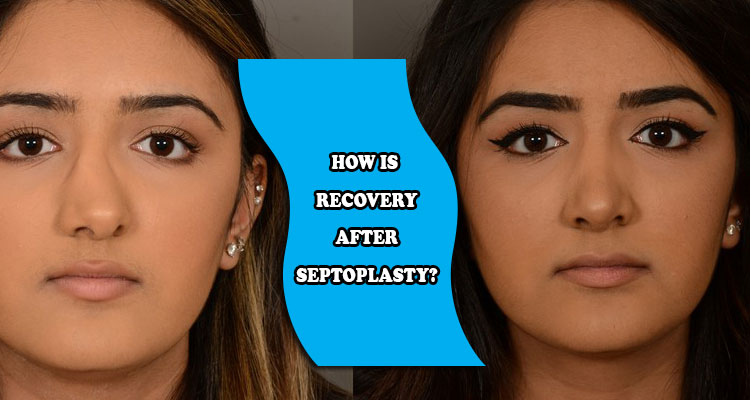
After the revision rhinoplasty in Iran, you can help recovery by following these tips:
- Do not blow your nose
- Raise your head while sleeping.
- Avoid formidable exercise, including aerobic exercise.
- Wear clothes that cover the front of your head.
What side effects may occur?
If left untreated, severe septal deviation can cause complications. A common complication is obstruction of one or both nostrils. This can cause:
- Chronic sinus problems
- Breathe loudly during sleep
- Sleep is disturbed
- Just being capable of sleeping on one side
Other side effects include:
- nose bleeding
- Facial pain
- Dry mouth
- Disturbed sleep
- pressure or density in the nasal passages
Is asymmetry normal after rhinoplasty?
As with any surgery, there will be tenderness and swelling after your nose surgery. Because you will not experience this swelling exactly the same on each side, asymmetry is normal after rhinoplasty.
You may experience swelling or deformity in your nostrils as well as the sides and bridge of your nose after surgery. It takes about two weeks to see the initial results of your rhinoplasty after enough swelling has subsided. However, at this stage it is still too early to know what elements of asymmetry will remain in the long run.
Of course, your doctor will give you complete instructions after surgery to minimize asymmetry from swelling. Instructions include using contacts instead of glasses to prevent pressure on the bridge of the nose, and avoid rubbing your nose as this can change the outcome of your operation.
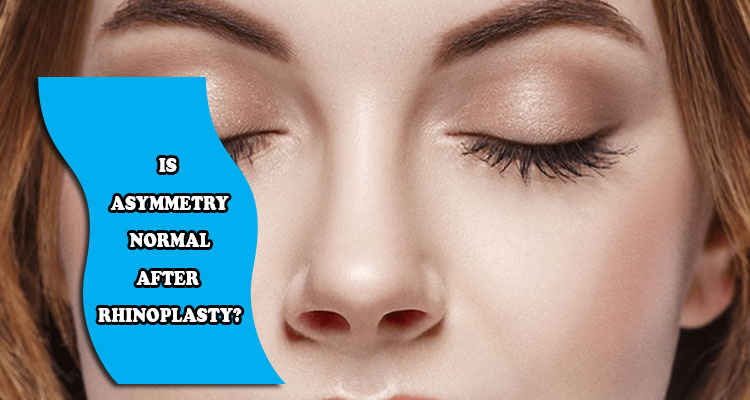
See results gradually over time
While you will start seeing initial results in about two weeks, it may take up to twelve months to see your full results. You will notice subtle changes over time. This includes the gradual reduction of swelling and the significant disappearance of asymmetries.
On average, seeing the final results of your rhinoplasty occurs between six and twelve months after surgery. Some swelling may persist during this time and may even be more or less depending on the time of day. For example, you may see more swelling after sleep and less swelling during the day.
Reasons for revision rhinoplasty in Iran
The nose plays a very important role in the beauty and harmony of the face. In this regard, the emotional impact of an unsuccessful rhinoplasty on patient can be devastating in some cases. In addition, the nose has other important elements with important roles that may be damaged in the first rhinoplasty. Accordingly, it leads to instability of the nasal tissues, which often leads to further deformity through the gradually progressive distortion of the nasal skeleton, usually with a corresponding nasal function deterioration. In these cases, revision rhinoplasty in Iran will be required.
The principles of secondary rhinoplasty are almost identical to those of primary rhinoplasty. It is important to consider nasal balance, function, cartilage and bone deformities, areas that need additional support or reshaping, and designing a safe program that meets the patient’s aesthetic goals as much as possible.







